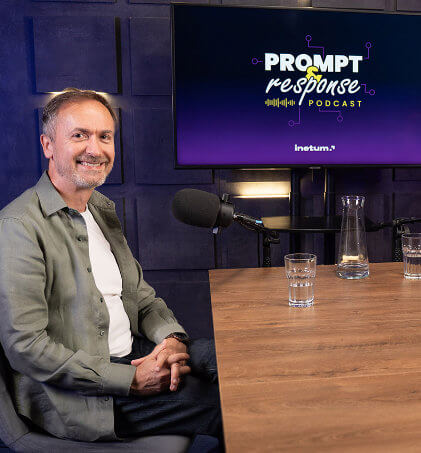In the second episode of Prompt & Response, host Piotr Mechliński talks with Wiktor Zdzienicki, Head of Data & AI Practice at Inetum about one of the biggest challenges companies face today: moving from AI hype to a business-led AI strategy that delivers real value. They explore why most pilots stall, which pillars support long-term success, and how to balance risks, regulations, and adoption. The conversation also includes a practical, five-hour AI discovery workshop format that any organization can run as a first step toward building its strategy.
Introduction
In the second episode of Prompt & Response, host Piotr Mechliński altogether with Wiktor Zdzienicki explore a challenge every organization faces in 2025: how to move from the hype around Artificial Intelligence to a truly business-led AI strategy that scales.
The discussion covers:
- why so many AI pilots fail to grow,
- the essential pillars of a sustainable strategy,
- the risks organizations must anticipate,
- how to select use cases that actually create value,
- introduction of a practical five-hour AI discovery workshop format that companies can apply right away.
- 1. Why so many pilots never go beyond proof of concept
- 2. The pillars of an AI strategy
- 3. Where to start: choosing the right use cases
- 4. Common risks to be aware of
- 5. What AI strategies will look like in the near future
- 6. Imagination, leadership, and courage
- 7. A practical shortcut: the AI discovery workshop
- 8. Conclusion
Why so many pilots never go beyond proof of concept
Eight out of ten AI pilots never progress to full deployment. This high failure rate often comes down to poor selection of proof-of-concepts, projects chosen at random with no real link to a business problem. Many organizations run pilots simply because the competition does, or because management expects it, not because there is a genuine need.
Another recurring issue is the lack of internal ownership. Without a leader who champions the initiative and aligns stakeholders, even technically successful outcomes remain unused. Teams may deliver working prototypes, but they are treated as isolated experiments rather than embedded business solutions.
Companies also tend to opt for small, risk-free pilots. These projects are easy to deliver but bring no measurable business impact. Instead of targeting use cases that could move KPIs or affect financial performance, organizations pick “safe” ideas and then struggle to prove their value when the pilot ends.
The pillars of an AI strategy
A robust AI strategy is not only about tools and technology. It should connect Artificial Intelligence to the company’s mission and ensure adoption across the organization. Five pillars are especially important:
- Business value: Every AI project must align with corporate goals and deliver tangible outcomes such as revenue growth, customer satisfaction, or efficiency.
- Data: High-quality, accessible, and timely data is the foundation of AI success.
- Culture and organization: People matter most. There must be leaders, champions, and adoption mechanisms to make solutions stick.
- Technology: Models, platforms, and MLOps practices are important, but they should come only after business needs are clear.
- Governance and ethics: In Europe especially, compliance, monitoring, and ethical frameworks cannot be ignored.
Many companies discover that culture and processes, rather than technology, are the main blockers. Tools do not transform businesses, people do.
Consult your project directly with a specialist
Book a meetingWhere to start: choosing the right use cases
Organizations often wonder how to begin. The answer is not in massive transformation programs or trivial pilots. The best place to start is with quick wins that bring real value.
A practical method is the impact–feasibility matrix, which helps teams identify cases that are both realistic and meaningful. Workshops with business areas such as sales, finance, or operations often generate ideas ranging from small process improvements to ambitious AI-driven innovations.
At the same time, leaders should avoid blindly following hype. Just because chatbots are popular does not mean your company should build one. Sometimes, the real priority is more fundamental, such as fixing reporting or data warehousing. In many projects, “AI” initiatives eventually turn into analytics or BI improvements, because that is where the true value lies.
Also read:
- The rise of AI agents – your new digital coworkers
- AI marketing agents are reshaping how campaigns are built, approved, and delivered
- Revolutionizing coding with the AI coding agent
Common risks to be aware of
Several risks regularly derail AI initiatives:
- Data quality and access: If inputs are incomplete or outdated, the solution quickly becomes irrelevant and may be abandoned within weeks.
- Adoption by employees: Staff who have done their work for years without AI often fear change. Without careful communication and a clear demonstration of benefits, adoption will stall.
- Analysis paralysis: In large or highly regulated companies, months or even years are sometimes spent creating 300-page strategy decks. By the time they are complete, they are already outdated, because technology changes in quarters, not decades.
What AI strategies will look like in the near future
In the next two years, AI strategies will likely become shorter, more iterative, and closer to the business. They will have to account for stricter regulations while constantly refreshing focus, since what is advanced today may be obsolete tomorrow.
Instead of lengthy documents, organizations will move toward lean approaches: iterative roadmaps, actionable guidelines, and strategies that evolve with each new technology wave.
Imagination, leadership, and courage
AI is not just about tools. It is a chance to rethink business models. This requires time for reflection, honest discussion, and leaders who have the courage to break routines. The most dangerous sentence in business remains: “We’ve always done it this way.”
Organizations need leaders who combine imagination with humility. They must be open to testing new paths and willing to accept that ego should never block innovation.
A practical shortcut: the AI discovery workshop
For companies that want to move quickly, a five-hour AI discovery workshop can be the perfect first step. It covers four stages:
- Inspiration: Industry-specific case studies to show how others apply AI and data.
- Demystification: A quick overview that clarifies what AI really is, moving beyond the “AI = GPT” simplification.
- Ideation: Hands-on exploration of a chosen business area, identifying processes and roles where AI can create measurable value.
- Strategizing: Consolidating insights into the foundation of an AI strategy.
The aim is not to create a final strategy in one session but to ensure organizations leave with more than just a list of use cases. A list is not a strategy. Participants gain a clear sense of what needs attention in the future and practical guidance on how to continue the journey.
Conclusion
The five-hour workshop can be seen as a miniature version of a full AI strategy exercise, or as a demo of how to build one in the long run. It is the first step toward a comprehensive, business-led AI roadmap.
Ultimately, Chat GPT, Google Gemini, Claude Code and other AI tools are only part of the story. The real value comes from combining the capabilities of AI with human creativity, business knowledge, and leadership courage.
If you are considering building an AI strategy, even starting with something as simple as a discovery workshop, reach out to us. We will be glad to explore opportunities and work with you.

Ready to take the next step?
Your AI journey starts with a conversation. Share your challenge, idea, or question, and our experts will respond with insights and practical guidance. Talk to us- 1. Why so many pilots never go beyond proof of concept
- 2. The pillars of an AI strategy
- 3. Where to start: choosing the right use cases
- 4. Common risks to be aware of
- 5. What AI strategies will look like in the near future
- 6. Imagination, leadership, and courage
- 7. A practical shortcut: the AI discovery workshop
- 8. Conclusion
